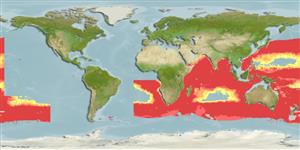Actinopterygii (ray-finned fishes) >
Myctophiformes (Lanternfishes) >
Myctophidae (Lanternfishes) > Lampanyctinae
Etymology: Lampanyctus: Greek, lampas, -ados = torch + Greek, nykte = night (Ref. 45335).
Environment / Climate / Range
Ecology
Marine; bathypelagic; oceanodromous (Ref. 51243); depth range ? - 1757 m (Ref. 280). Deep-water, preferred ?
Indo-West Pacific: Agulhas Current and off the west coast in Agulhas Water pockets (South Africa); also in tropical and subtropical waters between the South China Sea and the western Indian Ocean. Reported from Japan (Ref. 559) and Taiwan (Ref. 39633).
Size / Weight / Age
Maturity: Lm ? range ? - ? cm
Max length : 7.0 cm SL male/unsexed; (Ref. 4066)
Dorsal
spines
(total): 0;
Dorsal
soft rays
(total): 12-14;
Anal
spines: 0;
Anal
soft rays: 16 - 19. Anal organs 13-14; the elevated, anteriorly displaced second ventral organ (anterior of the vertical from first ventral organ) and the low anal organ and gill raker counts easily separate this species from all other congeners (Ref. 39633).
High-oceanic and mesopelagic; occurs in the upper 212 m at night.
Life cycle and mating behavior
Maturity | Reproduction | Spawning | Eggs | Fecundity | Larvae
Hulley, P.A., 1986. Myctophidae. p. 282-321. In M.M. Smith and P.C. Heemstra (eds.) Smiths' sea fishes. Springer-Verlag, Berlin. (Ref. 4066)
IUCN Red List Status (Ref. 115185)
CITES (Ref. 94142)
Not Evaluated
Threat to humans
Harmless
Human uses
More information
Common namesSynonymsMetabolismPredatorsEcotoxicologyReproductionMaturitySpawningFecundityEggsEgg development
ReferencesAquacultureAquaculture profileStrainsGeneticsAllele frequenciesHeritabilityDiseasesProcessingMass conversion
Tools
Special reports
Download XML
Internet sources
